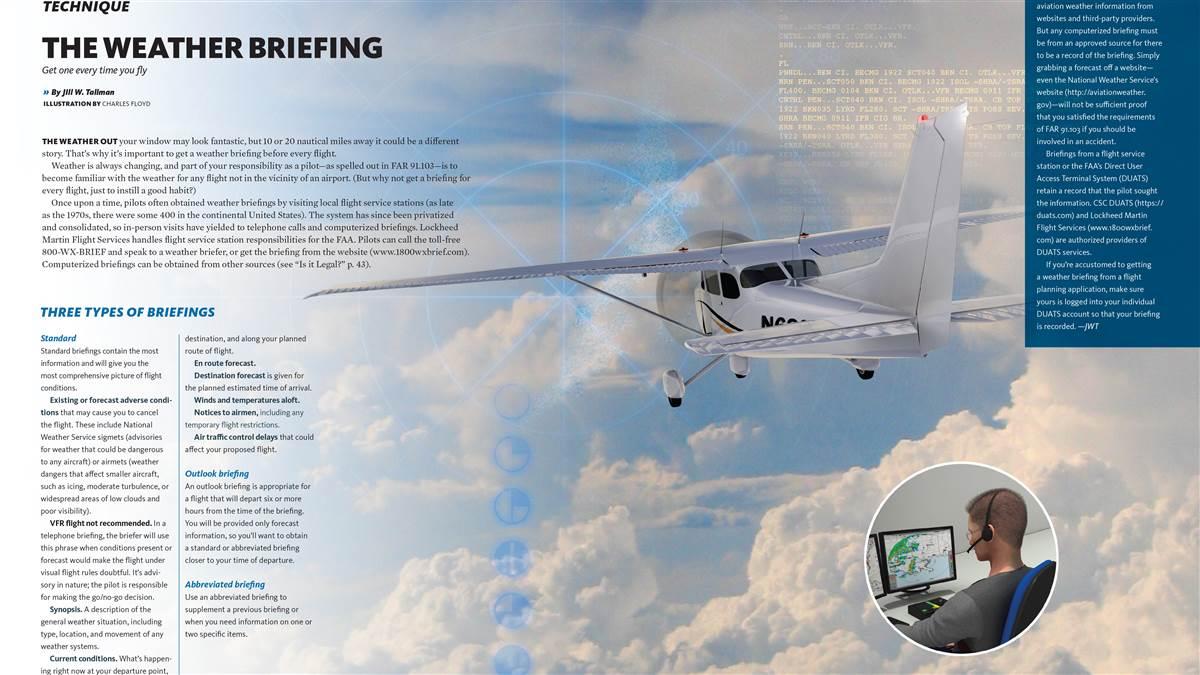Technique: The weather briefing
Get one every time you fly

Is it legal?
Pilots may obtain an abundance of aviation weather information from websites and third-party providers. But any computerized briefing must be from an approved source for there to be a record of the briefing. Simply grabbing a forecast off a website—even the National Weather Service’s website (http://aviationweather.gov)—will not be sufficient proof
that you satisfied the requirements of FAR 91.103 if you should be involved in an accident.
Briefings from a flight service station or the FAA’s Direct User Access Terminal System (DUATS) retain a record that the pilot sought the information. CSC DUATS and Lockheed Martin Flight Services are authorized providers of DUATS services.
If you’re accustomed to getting a weather briefing from a flight planning application, make sure yours is logged into your individual DUATS account so that your briefing is recorded. —JWT
Weather is always changing, and part of your responsibility as a pilot—as spelled out in FAR 91.103—is to become familiar with the weather for any flight not in the vicinity of an airport. (But why not get a briefing for every flight, just to instill a good habit?)
Once upon a time, pilots often obtained weather briefings by visiting local flight service stations (as late as the 1970s, there were some 400 in the continental United States). The system has since been privatized and consolidated, so in-person visits have yielded to telephone calls and computerized briefings. Lockheed Martin Flight Services handles flight service station responsibilities for the FAA. Pilots can call the toll-free 800-WX-BRIEF and speak to a weather briefer, or get the briefing from the website. Computerized briefings can be obtained from other sources (see “Is it Legal?” p. 43).
Three types of briefings
Standard
Standard briefings contain the most information and will give you the most comprehensive picture of flight conditions.
Existing or forecast adverse conditions that may cause you to cancel the flight. These include National Weather Service sigmets (advisories for weather that could be dangerous to any aircraft) or airmets (weather dangers that affect smaller aircraft, such as icing, moderate turbulence, or widespread areas of low clouds and poor visibility).
VFR flight not recommended. In a telephone briefing, the briefer will use this phrase when conditions present or forecast would make the flight under visual flight rules doubtful. It’s advisory in nature; the pilot is responsible for making the go/no-go decision.
Synopsis. A description of the general weather situation, including type, location, and movement of any weather systems.
Current conditions. What’s happening right now at your departure point, destination, and along your planned route of flight.
En route forecast.
Destination forecast is given for the planned estimated time of arrival.
Winds and temperatures aloft.
Notices to airmen, including any temporary flight restrictions.
Air traffic control delays that could affect your proposed flight.
Outlook briefing
An outlook briefing is appropriate for a flight that will depart six or more hours from the time of the briefing. You will be provided only forecast information, so you’ll want to obtain a standard or abbreviated briefing closer to your time of departure.
Abbreviated briefing
Use an abbreviated briefing to supplement a previous briefing or when you need information on one or two specific items.



